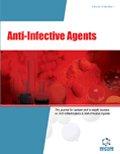Abstract
This paper reviews the inhibition of various enzymes by neuroleptics, anti-mycotics, antibiotics and other drugs on three species of human pathogenic amoebas, mainly Entamoeba histolytica, Acanthamoeba polyphaga and Naegleria fowleri, and their antiproliferative effects. A recent patent registered by Philip relates to the combination of an antibacterial formulation and antifungal agent for producing a therapeutically effective quantity of an antimicrobial that is suitable for suppressing or treating fungal growth. The rationale behind this patent focused on essential and valid targets with a description of the main pathogenic characteristics of these amoebas. The study of new targets, such as trypanothione and trypanothione reductase, and the drug effects of selected agents were arranged into six main groups: A) Inhibition of disulfide reducing enzymes by neuroleptics, antimycotics and antibiotics; B) Comparative evaluation of the efficacies of several drugs with antiproliferative activities; C) Inhibition of the enzymes for the synthesis of trypanothione, such as ornithine decarboxylase, spermidine synthase and trypanothione synthetase; D) Inhibition of the glycolytic enzyme PPidependent phosphofructokinase (PFK) from Entamoeba and Naegleria by pyrophosphate analogues, different from the host enzyme; E) Inhibition of enzymes secreted by these parasites to invade the human host, for example cysteine proteinases; and F) Inhibition of encystment pathways and cyst-wall assembly proteins.
Keywords: Drug effects, neuroleptics, antimycotics, antibiotics, antiproliferative effects, Entamoeba histolytica, Acanthamoeba polyphaga, Naegleria fowleri






















